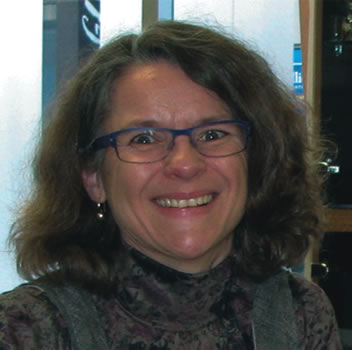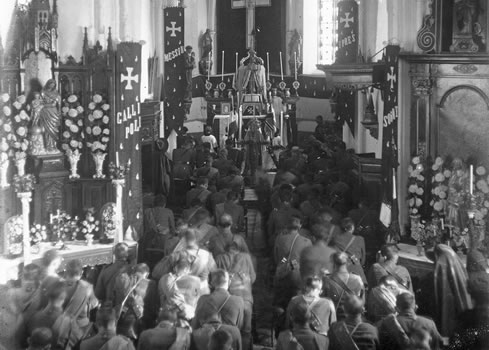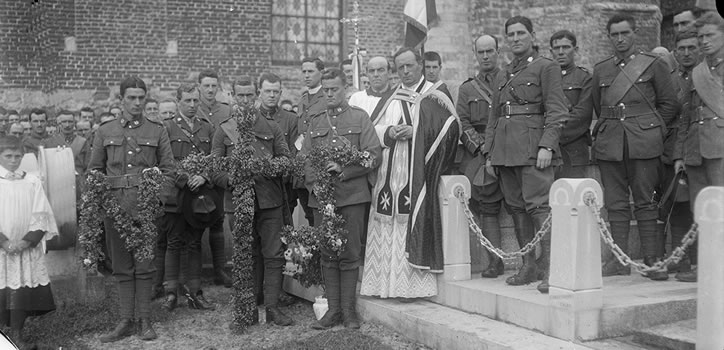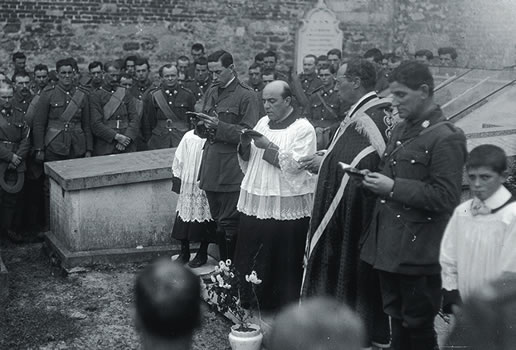A Contribution of the New Zealand Chaplains in France
Where the battles of northern France and Belgium were fought, were not empty plains but people’s villages and homes. The presence of our troops, their chaplains and their relationships also had an effect on the civilian population.
During different periods of 1917, the following New Zealand chaplains were stationed at Nieppe: Frs Barra SM, McMenamin, Skinner, O’Neill, Bartley SM and Segrief SM . This town, which is on the border with Belgium and roughly 10km from Messines, was used as a base for Allied soldiers from October 1914 to April 1918.
The Marist chaplains, Fr Jean Barra – himself a Frenchman, Fr Francis Bartley, Fr Thomas Segrief, (as well as Fr Leo Daly) had attended the seminary at Meeanee where tea time readings in the refectory were in French and they would have had French as part of their curriculum at secondary school and so would have been able to communicate in French.
It is here, in Nieppe, that the Wellington Diocesan priest, Fr James Joseph McMenamin, is buried and where this story begins.
In March 1917, Fr McMenamin wrote to Archbishop O’Shea:
Frs Barra and Daly and I had lunch and dinner together with the curé of one of the churches we used. He was a dear old man and simply insisted on our coming for both meals. There were 360 of our soldiers at Mass in his church alone and he was amazed at the size of the collection.
When we use the churches for Mass the boys always take up a collection for the Curé, and they give generously as they know the priests in France at the present time are very poor.
Apart from the war raging around them, why would Fr McMenamin write in particular that the priests were very poor? To understand the context of this comment, a sketch of the political and religious landscape of France at that time is required.
Even before the French Revolution there had been a slow movement of secularisation of the State. In 1889 a law was passed making priests complete compulsory military service. Over the ensuing years a greater feeling of anticlericalism spread throughout France, culminating with the 1905 law which finally separated churches (Catholic, Protestant and Jewish) from the State. The consequences of this were that churches became property of the State and priests, who until 1905 had been considered state employees, were from 1909 no longer entitled to any payment. It was into this situation that the Catholic chaplains and soldiers found themselves when posted to northern France.
It is believed that the priest acknowledged in Fr McMenamin’s letter is Fr Raphaël Vandaele, who had been Parish Priest of Nieppe since 1910 and was then aged 54. When Fr McMenamin was killed carrying out his duty at Messines a few months later, it was Fr Vandaele who arranged for his final resting place. He wrote in the Parish Register (one of the few remaining documents tracing the town’s history pre-1918):
9 June 1917, Father McMenamin, New Zealand chaplain, had been called to the burial of a Catholic soldier near Messines. While he was reciting the final commendation at the gravesite, a shell blew up near him and killed him. This very zealous chaplain, who was held in high esteem by his soldiers, was, on the wishes of this Parish Priest, brought to Nieppe where he was given solemn funeral rites.
The mayor gave permission for this priest to be buried in the parish priests’ vault. This act of goodwill was made known to and very appreciated by Archbishop O’Shea, Archbishop of Wellington (New Zealand).
12 June 1917 burial of Fr McMenamin
Referring to the earlier comment that churches had become property of the State, it is understood that that is why the mayor’s approval was required.
Fr Vandaele had also written to Archbishop O’Shea on 22 March 1917:
Your soldiers also know how to invoke the aid of Heaven, and on Sundays they give our faithful population a good example of their deep faith. Their behaviour is dignified and respectful in church, their song is sweet and pious, their prayers are fervent, their attendance and their uplifting attitude to the Holy table are worthy of praise.
It appears that the masses conducted by our chaplains were not solely for soldiers but were also attended by civilians. Marie Houcke, a resident of Nieppe, wrote in her diary of attending some English-language masses, which apart from the sermon, would have been in Latin of course, though with an English accent!! She found this to be an interesting experience.
In the same letter, Fr Vandaele also mentioned how impressed he was with the generosity of the faithful towards the first victims of the war: alms sent from the Wellington Archdiocese had consoled Belgian refugees. On Fr Barra’s advice, he asks again if any donations could come the way of his Parish (there were 3000 inhabitants in his flock). From 1916 onwards the town had been systematically destroyed through shelling; at the end of the war only three buildings remained standing.
It is unfortunate that Archbishop O’Shea’s letterbook of that time has not survived; however, it is clear from Fr Barra’s correspondence with the Archbishop that the latter responded to Fr Vandaele’s request. In a letter dated 1st March 1919, Fr Barra acknowledges receipt of £20, but had not had success in making contact. He further writes a few days later in the same letter:
It gives me great pleasure to tell you that the Curé of Nieppe has been found and expresses much gratitude for help obtained. At present he lives in an old dug-out in the ruined village with a few parishioners who have come back. Trusting in Providence the old man made a start in reconstruction last Sunday when the Bishop of Lille came down to bless the foundation stone of a new church.
Fr Vandaele did not see to the completion of the reconstruction which took until 1929; he was moved to Bergues in 1921 where he remained until his death in 1936.
The conduct of the New Zealand Catholic soldiers is a recurring theme in records found.
Fr Bartley (while he studied and ministered in New Zealand, hailed from Australia) wrote:
I never knew we had such lads in New Zealand as our Catholics have shown themselves over here. It is now the regular thing for the boys to go to Confession and Holy Communion every week. If they are in the line or on fatigue duty on Sunday, they come along of a week night. They are splendid fellows, and we, their priests, are honoured in being with them.
These displays of faithfulness also had an impact on the civilian French population. Father Adolphe Roger, Parish Priest of Selles (Pas de Calais) wrote in his report to his Bishop after the end of the war:
The Australian and New Zealand troops who came here to regroup after the violent battles around Ypres had a very positive influence on the local population’s morale. Among these troops were a good number of devout Catholics; they often had their special mass on Sundays. Their edifying piety led those who were witnesses. With their contact, there was a renewed increase in religious practices and, in 1917, communions among the civilian population amounted to 6400.
As already evidenced in Nieppe, the chaplains and French Parish Priests developed and maintained cordial relations. This also occurred behind the main lines, such as in Selles.
Fr Barra was approached by Fr Adolphe Roger to use his church at Selles for a memorial service, which was held on 5 November 1917. Fortuitously, a visual record of this occasion was also captured by Henry Armytage Sanders, the official photographer to the New Zealand Expeditionary Force. These photographs form part of the Royal New Zealand Returned and Services’ Association New Zealand official negatives collection, held by the Alexander Turnbull Library.
Fr Barra described the service in his letter to Archbishop O’Shea dated 7 November 1917:
The parade came off all right; and on Monday 5th November, at 10 am the Holy Sacrifice was celebrated for the souls of our Heroes. The church was beautifully decorated. Black hangings covered the walls round; a large black cross stood well at the back of the altar; the catafalque was draped with a French flag, the flags of France and Britain posted in mourning at the four corners of it. In front of the sanctuary a large cross made of flowers, with the letters NZ made equally of flowers, gave to all the meaning of the ceremony. Over the sanctuary arch a banderolle was hung with these words upon it, “Eternal Rest Grant to Them, o Lord”. Against the four pillars of the nave could be seen in large silver letters the four names of NZ fame in this war: Gallipoli, Somme, Messines, Ypres. The Curé sang the mass and the parish choir executed the liturgical singing with great sweetness and devotion. All the boys went to Holy Communion, led by their officers who knelt first at the Holy Table. It was a magnificent act of faith which brought tears to the eyes of the French people present.
Fathers Bartley and Segrief had come to help me and the work went on quickly and well: I feel sure that God was pleased with the men. After a short sermon the men marched out of the church into the cemetery where the burial service was solemnly read for the dead who in the line have never had the blessing of the Holy Church over their sacred remains. It was most impressive! Four priests stood there at the foot of the Cross of Salvation, by the side of the immortal flag of France in the hands of a veteran wounded at Verdun, and all our noble NZ Catholic soldiers around. Angels of heaven, who witnessed the faith and devotion of those men, the religious silence of heroes as the glorious words of the Ritual were read out, write that scene down in the records of God! Carry to the trenches the protecting blessing of Christ and give joy to the bones of those who now sleep there, their last long sleep! “Exultabunt ossa humiliate! [humbled bones shall rejoice, Psalm 51:8]”
This was considered of such importance by the local clergy that Fr Roger also included it in his report to his Bishop. Besides what Fr Barra recorded, Fr Roger added:
We managed to accommodate more than 300 soldiers in the church… In the evening the Colonel came to the presbytery to give his warm thanks. The Daily Mirror of 15 February 1918 printed several photos taken by the official photographer.
Even though 100 years has passed, the French continue to be grateful towards the New Zealand troops who came to their aid and acknowledge the sacrifice of those who died in the fight for their freedom.
I would like to acknowledge the assistance of the following institutions without whose material this piece could not have been written;
Marist Archives Wellington ,
Wellington Archdioscesan Archives, Diocesan Archives of Lille,
Diocesan Archives of Arras,
Niepkerke: Nieppe’s Historical Society.
1 Diocesan Archives of Lille
2 Marist Archives Wellington
3 Wellington Archdiocesan Archives
4 Diocesan Archives of Lille
5 Wellington Archdiocesan Archives
6 Niepkerke: Nieppe’s Historical Society
7 Wellington Archdiocesan Archives
8 Marist Archives Wellington
9 Diocesan Archives of Arras
10 Wellington Archdiocesan Archives
11 Diocesan Archives of Arras




 Entries(RSS)
Entries(RSS)